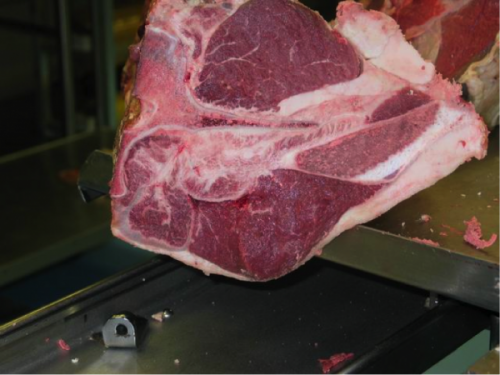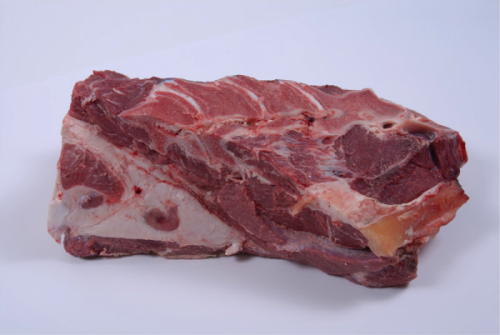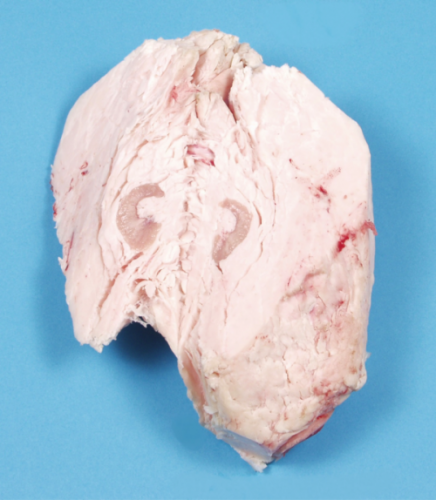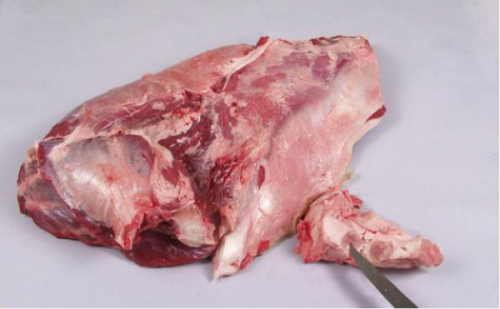Darker Cut Beef Is Mainly Caused by
Meat Scientific discipline and Nutrition
Meat Colour
The mail mortem colour evolution of meat varies profoundly from one species to another, with variations in fresh beef existence very prominent. Beef shows a range of colour from first being cut to the end of its shelf life (about three days).
Typical meat colour for different species is shown in Table 3.
| Species | Color |
| Beef | Vivid crimson ruby-red |
| Fish | Pure white to grey-white or pink to dark red |
| Horse | Nighttime red |
| Lamb and mutton | Light crimson to brick red |
| Pork | Greyish pink |
| Poultry | Grey-white to dull red |
| Veal | Brownish pink |
Meat colour is significant to consumer acceptance of products. The bright red colour of practiced quality beef, sockeye salmon, and young lamb are naturally appealing, whereas the paler colours of veal and other fish species are less appealing to many (although more than sought afterward by some ethnic groups). Dark meats such as horse are more popular in Quebec and European countries. Mutton (sheep over 12 months of age with darker flesh) appeals to an even smaller range of customers.
Factors Affecting Colour
Employ of Muscles
Poultry provides a good opportunity to run into and larn nearly the differences in meat color. Meat cutters and cooks may often be asked why different parts of a chicken have and other parts take , or why duck or game birds have generally nighttime meat.
The colour of the meat is adamant by how the muscle is used. Upland game birds, such as and grouse, that fly only for curt bursts have white chest meat. In contrast, ducks and geese and most other game birds that fly long distances have exclusively dark meat. In domestic poultry (chickens and turkeys), there is a deviation between breasts (white meat) and thighs and drumsticks (dark meat).
Note: Chicken thighs, fifty-fifty when fully cooked, may have a reddish tinge and claret seepage from the thigh bone. This is normal; still, inexperienced customers may interpret this equally a sign of non beingness cooked properly.
Proteins
Meat color is associated with ii proteins: (in the muscle) and (in the blood). When animals are no longer alive and air comes in contact with the meat, myoglobin reacts with oxygen in an attempt to reach a country of equilibrium, at which point no further changes occur. As this process happens, the meat colour goes through three stages and three colours that are easy to meet, especially on freshly cutting beefiness meats.
- Purplish red (myoglobin): occurs immediately after a is sliced.
- Ruby red (oxymyoglobin): occurs several minutes after cutting and later on exposure to oxygen.
- Brown (metmyoglobin): occurs when the iron in the myoglobin is oxidized, which usually takes about iii days afterwards cut. (You may see steaks with this colour in the discount bin at a supermarket. The brownish colour doesn't mean at that place is anything wrong with the product; in fact, purchasing meat at this phase is a groovy way to stock up on cheaper steaks for the freezer.)
Oxygen
Oxygen plays two of import roles, which affect the colour in opposite ways. As soon as meat is cut, oxygen reacts with the myoglobin and creates the bright red color associated with oxymyoglobin. This volition proceed to develop until the iron in the myoglobin oxidizes to the point of the stage.
Oxidation can too occur when iron in the meat binds with oxygen in the muscle. This can often occur during the processing of round steak from the hip cardinal and can be identified by the rainbow-similar colours that appear from the reflection of low-cal off the meat surface. The condition volition remain later the production is cooked and can oft be seen on sliced roast beefiness used in sandwich making. This condition does not modify the quality of the meat; however, it is generally less attractive to consumers.
Age
The pale muscles of veal carcasses bespeak an immature animate being, which has a lower myoglobin count than those of more than mature animals. Young cattle are fed primarily milk products to keep their flesh light in color. However once a dogie is weaned and begins to eat grass, its mankind begins to darken. Intact males such equally convenance bulls have musculus that contains more myoglobin than females (heifers) or steers (castrated males) at a comparable age.
Mostly, beef and lamb have more than myoglobin in their muscles than pork, veal, fish, and poultry. Game animals have muscles that are darker than those of domestic animals, in function due to the higher level of concrete activity, and therefore they also have college myoglobin.
Preventing Discolouration
Maintaining the temperature of fresh meat most the freezing point (0°C/32°F) helps maintain the vivid ruddy colour () of beefiness meats for much longer and prevents discolouration.
Meat should exist allowed to blossom completely (the flower commonly reaches its peak about three or four days after cutting) or be wrapped on a meat tray with a wrapping movie equally in supermarket meat displays. If portioned steaks are to exist vacuum packed, doing so immediately later cutting (merely earlier the bloom has started) volition allow the steaks to flower naturally when removed from the vacuum packaging.
Certain phases of meat processing can besides trigger discolouration. Oxidation browning (metmyoglobin) tin can develop more rapidly than normal if something occurs to restrict the flow of oxygen once the bloom has started but has not been allowed to run its full course. The two most common examples are:
- Cut meat surfaces stay in contact besides long with flat surfaces such as cutting tables, cut boards, or trays.
- Meat is wrapped in paper (which means there is no further exposure to air and therefore no oxygen, which speeds up the browning effect).
The browning outcome will occur naturally one time the meat is exposed to oxygen.
There are ii other types of discolouration that commonly occur with beefiness and pig meat. Although the cause of both types occurs before death (), the bodily change does non evidence upward until afterwards death (mail mortem). The discolouration is a result of chemical reactions in the animal's trunk due to stresses, known as .
PSS can issue in 2 different types of discolouration: PSE and DFD.
(pale, soft, and exudative) occurs mainly in pigs (and in some cases has been found to be genetic). PSE is brought about by a sudden increase of lactic acid due to the depletion of glycogen before slaughter, which in plough causes a rapid decline in the pH postal service slaughter. The visible signs of PSE can be detected by the trained eye in the pork loin fundamental, where the flesh appears much paler than normal. The muscle meat is softer and may be very sloppy and wet to the touch and leaking meat juices, a result of a loftier proportion of free water in the tissues.
Although product with PSE is condom to eat, its shelf life is express and it may become tougher sooner if overcooked. Products with PSE accept limited use as fresh products but are used to manufacture cooked products such as formed ham and certain sausage varieties with a recommended limit of 10% (i.due east., one part PSE to ix parts of regular meat), due to the high water content.
(night, firm, and dry) occurs mainly in beefiness carcasses only sometimes in lamb and turkey. In the meat industry, these carcasses are referred to as . Unlike PSE meat, DFD meat shows little or no drop in the pH after slaughter. Instead, there may be an increase of stress hormones, such equally , released into the bloodstream. Consequently, (musculus saccharide) is depleted earlier slaughter due to stresses. This decreases the lactic acid, which in plow affects the pH, causing it to not drop fast enough after slaughter. Therefore, the muscle meat, typically in the hip area of the carcass, may go very dry out and nighttime.
Even later on the carcass is anile and the meat has been processed and displayed, the dark appearance remains and flower volition non occur. In addition, the meat may also feel sticky to the touch on, which limits shelf life. DFD meat is generally considered unattractive to the consumer; all the same, the meat remains edible and is all the same suitable for apply in cooked products and sausage emulsions but should exist limited to ten% (1 part DFD to 9 parts of regular meat).
Listed below are some causes of DFD that should be avoided:
- Transferring animals to foreign environs (kill plant) and holding them for too long
- Treating animals roughly prior to and during ship (e.g., using cattle prods)
- Overcrowding cattle during shipping
- Mixing cattle with other animals they are non used to
- Preventing animals from having sufficient rest at the butchery prior to harvesting
- Dehydrating animals (non giving them enough water) prior to slaughter
- Causing over-excitement, pain, hunger, excessive dissonance, smell of blood
- Exposing animals to temperature extremes during transportation
- Shipping stress-susceptible animals, such as intact males (bulls), during severe atmospheric condition
Note: DFD can occur anywhere betwixt 12 and 48 hours prior to an fauna's slaughter.
Imperfections and Abnormalities in Meat
Even though meats arriving at their final destination (indicate of auction) have normally been approved and inspected, the production yet requires further checks prior to sale and eating in case abnormal meat inconsistencies were missed in the inspection process. Some of these are caused by injuries or illness that occurred while the brute was alive, while others are naturally occurring parts of the animal's body (glands in detail) that are removed prior to or during the cut process.
Some examples are given here.
- and : infected or non-infected tumours from old injuries that are imbedded in muscles and sometimes close to bones (Figure nine).

- : normally from more than contempo injuries and also found imbedded in muscles or betwixt muscle seams or on or near os joints.
- : scar tissue, commonly from very quondam injuries, with the appearance of white fat seams or thin strands tightly bound together, making the muscle tough and unsightly.
- and : lymph nodes are glands in the pharynx and dorsum of the natural language that give a expert indication of the general wellness of the animal; these are inspected on the animal carcass at the harvesting establish prior to being sold, but internal or intermuscular glands are not examined unless farther inspection is recommended by a veterinary. Consequently, 3 major glands are removed from beefiness, pork, and lamb during processing to ensure the public do not see them. They are the , located in the neck and blade sub-primals below the junction of the fifth cervical vertebra (Figure 10); the , located at 90 degrees to the round bone on the hip on the exterior of the sirloin tip imbedded in the cod fat pocket (Effigy 11); and the , located in the outside round sub-central in the hip primal between the eye of the round and the outside round flat under the heel of round, imbedded in a fat pocket (Figure 12).



Source: https://opentextbc.ca/meatcutting/chapter/meat-colour/
0 Response to "Darker Cut Beef Is Mainly Caused by"
Postar um comentário